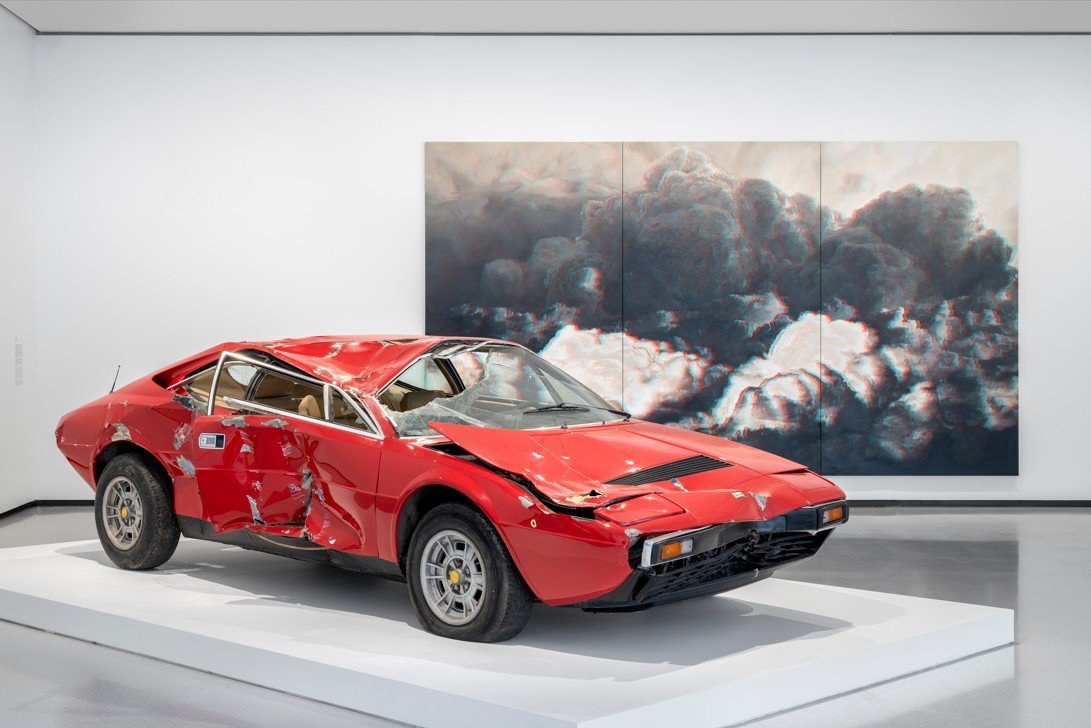
"The most important thing was not to touch the car." — Bertrand Lavier
An interview with Bertrand Lavier by Jean-Marie Gallais, the curator of the exhibition "Le monde comme il va".
Jean-Marie Gallais : Here we are in front of Dino (1993).
What happened here?
Bertrand Lavier : That was 30 years ago. There was something like a contraction of time. One of the most striking aspects of this work when you look at it is that you feel as if you are going through a patch of turbulence.
J-M.G : You found the car in a scrapyard. There’s still broken glass inside and dirt from the side of the road. At the same time, there is the red of the Ferrari paintwork, still perfectly gleaming. There's something very meticulous about the way it has to be presented.
B.L : It's an extremely fragile work that can't stand a milligram of dust, because that would turn it into just a wreck. This accident happened with a Ferrari. And Ferrari is a brand, the world of racing, the world that comes with a certain type of car. So, the accident is almost inherent to this brand because there is danger. It's synonymous with both a sense of journeying and of danger. I wouldn't have made this using a Renault R5! It's an ordinary accident involving an extraordinary car. When I wanted to make this piece, I set very simple rules for myself. I didn't want anyone to die in the car. I made sure of that, and at that point, I was able to make it my own. The disaster has to be seen at an angle. There has to be an angle, a sense of remove.
J-M.G : You talk about the concept of appropriation. The gesture consists of exhibiting it, placing it on this immaculate, white base, in a space where you wouldn't expect to find a car, namely a museum.
B.L : The most important thing was not to touch the car. There is no manipulation. I would say that it's in this non-gesture in reverse that the work is able to flourish.

J-M.G : In looking at this car, which is a wreck, the victim of a rather serious crash, we suspect that it may have rolled over a few times, because there are dents on every surface. And so, we wonder, is this right? Is it OK to contemplate this, or are we engaging in voyeurism? How did you work along this line?
B.L : The voyeurism is ultimately in a very minor key. Thirty years ago, when I transported this car to exhibit it in Paris, we put it on a truck. And when the truck driver stopped for petrol on the motorway, one of the people at the service station saw the car and went up to the driver and said: “It must be a sculpture”. I think this anecdote clearly illustrates Duchamp's sentence: “It's the viewer who makes the painting”.
J-M.G : So this was in 1993, but as we said, time is a contraction; it doesn’t exist with this car.
Looking at it today, in 2024, it still carries a message. The work is subject to multiple interpretations.
B.L : Yes, there are many ways of interpreting it. I conceived this work at a time, which was very much linked to a context that I would call highly post-Duchampian. This refers to the ready-made, to the beauty of indifference, to looking at an object for which we had almost no feelings. And so, I was interested in doing the opposite: putting the viewer in front of an object that I had absolutely nothing to do with, but which stood at the other end of the spectrum from the beauty of indifference.
J-M.G : The work is featured in the exhibition called Le monde comme il va, and so, it also becomes a response. The world as it is is a world that is hitting a wall, because there is too much; there is excess. There is also an exceeding of speed limits, even in a metaphorical sense. Next to, or rather, behind this car, we are exhibiting a huge painting of an explosion or a fire by German artist Anne Imhof, and a little farther away, a leather jacket by this same artist, which is like a relic. Underneath this leather jacket lies a pile of sugar, as if this energy had evaporated, had been wasted, as in this explosion or in this car that spun out of control. There is also this notion of an imbalance. For that matter, should I call this a “car” or a “sculpture”? How do you see it?
B.L : If you wanted to sum up what I do, you could say that I’m embedding an uncertainty principle in just about everything. Language itself is a source of uncertainty, so you can call it whatever you wish.
J-M.G : This car is part of what you call the “work sites”.
B.L : These “work sites” are often referred to as “ready-destroyeds”, surely a tongue-in-cheek reference to the ready-mades. It’s obvious that I didn't get to this point by using hammers and files to get it to look like this. Obviously, the idea of a work site is something that suits me because, in fact, you can keep it open ad infinitum; you can give up on it and come back to it later. So, if one day I find another car like this, and if I feel like it, I may not stop myself from starting over again.